
Today marks the fourteenth installment in a series of articles by HumanProgress.org called Centers of Progress. Where does progress happen? The story of civilization is in many ways the story of the city. It is the city that has helped to create and define the modern world. This bi-weekly column will give a short overview of urban centers that were the sites of pivotal advances in culture, economics, politics, technology, etc.
Our fourteenth Center of Progress is Benin City, whose walls were once arguably the largest manmade structure on the planet. The wall network of Benin City was collectively four times longer than the Great Wall of China and consumed roughly a hundred times more material to build than the Great Pyramid of Giza in Egypt, according to some estimates. Benin City was the capital of the Benin Empire (1180–1897 AD), which was among the most highly developed states in sub-Saharan Africa before the European colonial period. Benin City was also known for its bronze artworks and a high degree of public order in its heyday. Prosperity requires physical safety from violence and property protection from theft or conquest, and the unprecedented scale of Benin City’s protective walls represented a significant achievement in security.
While the Walls of Benin City eventually fell to a military attack, the record-breaking structure successfully safeguarded the lives and property of those who lived within the city for centuries.
Today, Benin City is the capital and most populous city of Edo State in southern Nigeria, about 200 miles east of the economic and cultural hub of Lagos. Benin City is not to be confused with the country of Benin, which neighbors Nigeria to the west. A major urban center in coastal West Africa, Benin City is home to over 12 million people. Prominent local industries include rubber and oil production. Benin City is known for its festivals, rich dress culture, and for being the site of the royal palace of one of the world’s oldest sustained monarchies—although today, the monarchy is largely ceremonial. The current Oba, or traditional ruler, of the local people, was crowned in 2016 and is considered the 40th Oba of Benin. His palace is a UNESCO World Heritage Site.
The Benin Empire or kingdom, also sometimes called the Edo kingdom, originated sometime around the 10th century AD when the Edo people first settled in the rainforests of West Africa. The empire’s traditional starting year is given as 1180 AD. By the 15th century AD, the Benin Empire was an established regional power. The empire grew wealthier both by conquering neighboring territories and by robust trade with Europeans—initially the Portuguese and later the British. The word “Benin” comes from a mishearing of a word in the West African language Yoruba by Portuguese traders in the 15th or 16th century AD. The story goes that during a royal succession dispute, political pressures led an Oba (king) to renounce his office. As the Oba gave up his title, in frustration, he publicly called the kingdom that he was surrendering the land of “Ibinu,” meaning vexation or anger. In the form “Benin,” the name stuck.
The capital of the Benin Empire was Benin City. If you could visit the city in its golden age, in the 17th century, you would observe a city so orderly that theft was practically unthinkable within its walls. Lourenco Pinto, the Portuguese sea captain of a missionary ship, wrote in 1691 AD, “Great Benin [Benin City], where the king resides, is larger than Lisbon. All the streets run straight and as far as the eye can see. The houses are large, especially that of the king, which is richly decorated and has fine columns. The city is wealthy and industrious. It is so well governed that theft is unknown, and the people live in such security that they have no doors to their houses.”
The city’s security allowed the residents to be highly productive. Pinto also wrote, “The artisans have their places carefully allocated in the squares which are divided up in such a manner that in one square [I] counted altogether one hundred and twenty goldsmith’s workshops, all working continuously.”
Although Pinto wrote “goldsmiths,” what he observed were almost certainly bronze-workers. The city produced thousands of bronze plaques and sculptures created using a technique called low-wax casting. The city’s historic artworks are widely considered to be among the best engravings made using that technique. Some of the bronzes depicted military exploits from the 16th-century period of rapid Benin Empire expansionism. Others represented trade and commerce, diplomacy, and dynastic history. However, most of the artworks were simply portraits of Benin’s nobility garbed in elaborate ceremonial clothing.
Benin City’s people also produced a great amount of cloth, which played a significant role in trade with European merchants. Other locally produced trade goods included pepper, palm oil, carved ivory, and beads made from cowrie shells and other materials. Benin City’s people also sold slaves—often neighboring Africans captured in battle—to the Europeans. Because, distressingly, like almost all ancient societies, the Benin kingdom practiced slavery.
Despite its security achievements defending against outside threats, a modern person would not wish to live in ancient Benin City. Benin City’s people practiced ritual human sacrifice with various rationales, including honoring a god of iron and petitioning the gods for profitable trade. The victims were often prisoners with criminal backgrounds. By the end of the 18th century CE, three or four human sacrifices occurred at Benin City’s river’s mouth annually, ostensibly to ensure good trade with European merchants.
Among the city’s most important imports were brass and copper ingots from the Europeans. The Benin Empire did not produce enough metal locally to supply Benin City’s prolific engraving and sculpture industries fully. Many of the city’s famed bronze artworks would not have been possible without the benefits of overseas trade. The Portuguese often sold bronze and copper to Benin City’s people in the form of metal bracelets called “manillas.” By the 16th century AD, manillas and other metal objects (such as bronze pots and pans) were a standard trade currency used by Europeans in West Africa.
As trading grew more sophisticated, early factories or centers for the production of local goods like cloth sprung up along the main Benin City river. Always mindful of security, the Benin kingdom entered into various alliances to prevent piracy of trade goods.
Given the importance of trade to Benin City’s success, it is fitting that one of the city’s most beloved historical figures was a market woman. Her statue now graces a prominent place in Benin City. Emotan was a 15th-century merchant who, according to oral tradition, sold her wares at the point where her statue now stands. She founded the first childcare center in Benin City, opening up a nursery for the children of families patronizing Benin City’s marketplace. She once warned a prince of Benin of a plot against his life and helped him regain the throne from his brother. The new king then rewarded her by appointing her to a high position charged with enforcing security in the marketplace. Emotan is now locally revered and deified as the “conscience of justice.”
The city’s wealth grew thanks to its thriving markets and international trade, as well as due to the Benin kingdom’s successful imperialism. As the city became richer, that wealth improved its infrastructure and many of its people’s lives. “Houses are built alongside the streets in good order, the one close to the other,” noted the 17th-century Dutch writer Olfert Dapper. “Adorned with gables and steps and roofs made of palm or banana leaves, or leaves from other trees … they are … usually broad with long galleries inside, especially so in the case of the houses of the nobility, and divided into many rooms which are separated by walls made of red clay, very well erected.”
Dapper also noted that residents kept those walls “as shiny and smooth by washing and rubbing as any wall in Holland can be made with chalk, and they are like mirrors. The upper storeys are made of the same sort of clay. Moreover, every house is provided with a well for the supply of fresh water.”
Benin City was also notably among the first urban centers to have a likeness of street lighting. There were large metal lamps that burned palm oil, standing many feet high, placed around the city.
The king’s court was square and stood at the right side as one entered the city by its main gate. A wall like the one that encircled the city surrounded the court. The court housed various palaces, houses, and apartments for courtiers and boasted beautiful long and square galleries. Those galleries were “about as large as the Exchange at Amsterdam,” according to Dapper. The largest gallery hosted many of the city’s famed bronze carvings. Scenes engraved into bronze plaques stood supported by wooden pillars throughout the gallery.
However, Benin City’s wall network would have been the city’s most impressive sight. Radiocarbon dating of the walls’ remains suggests that the Edo people built up Benin City’s walls gradually over many years. Most of the construction likely occurred between 800 and 1500 AD.
“[T]he Benin [wall] network,” English author and journalist Fred Pearce wrote, “extend[s] for some 16,000 kilometres in all, in a mosaic of more than 500 interconnected settlement boundaries. They cover 6500 square kilometres and were all dug by the Edo people. In all, they are four times longer than the Great Wall of China, and consumed a hundred times more material than the Great Pyramid of Cheops. They took an estimated 150 million hours of digging to construct, and are perhaps the largest single archaeological phenomenon on the planet.”
The walls extended, in other words, for around 10,000 miles and covered some 2,500 square miles. That number of square miles is comparable to the Los Angeles-Riverside urban area in California today. Since Peace wrote those words, the official length of China’s Great Wall, defined to include various distinct border walls built in all dynasties of Chinese history, has been updated to around 13,000 miles. However, that figure, calculated by China’s State Administration of Cultural Heritage, has been called “misleading.” It includes many isolated, disconnected walls defending various state boundaries within China, not just China’s famed northern border wall. Estimates of the northern border wall’s length vary from 1,500 to 5,000 miles, depending on exactly which wall sections are counted. In any case, Benin City’s walls were certainly longer than China’s storied northern border wall.
In places, the towers of Benin City’s walls reached seven stories high. The walls also boasted guardhouses, ditches, moats, and garrison barracks. After guarding the city for centuries, the Walls of Benin fell to British troops in 1897 during a “punitive expedition” motivated by British revenge for an earlier military strike by the Benin Empire. However, trade disputes also motivated the attack. Many of the royal palace’s bronze artworks were captured in battle and are today displayed in the British Museum and various other museums.
After its walls fell, Benin City—and the Benin Empire—became part of the British Empire. Benin City then became part of Nigeria in 1960.

Safeguards against those who would steal or plunder have often proven indispensable in ensuring property rights. While the walls of Benin City eventually fell, for centuries, the record-breaking security feature protected the city. Human beings have created walls and other protective structures since they first switched from nomadism to permanent agricultural settlements. Many of the world’s oldest stationary communities took the form of walled cities—such as our inaugural Center of Progress, Neolithic-era Jericho. However, the Walls of Benin City surpassed all others in sheer scope. For the significant achievement in security of its record-shattering walls that stood for hundreds of years, Benin City is our fourteenth Center of Progress.
Heroes of Progress, Pt. 38: Cesare Beccaria
Introducing the Enlightenment thinker known as the father of modern criminal justice, Cesare Beccaria.
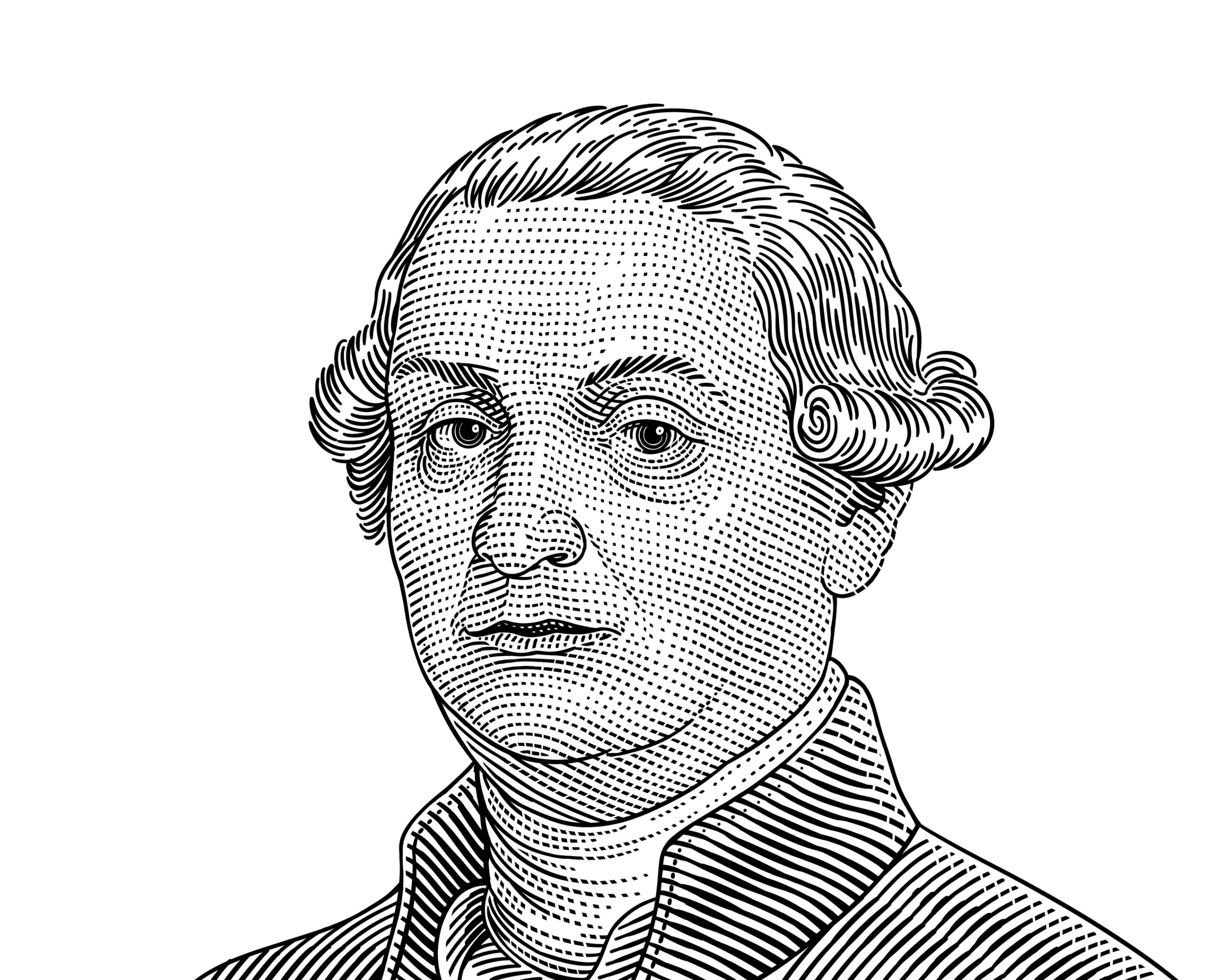
Today marks the 38th installment in a series of articles by HumanProgress.org titled Heroes of Progress. This bi-weekly column provides a short introduction to heroes who have made an extraordinary contribution to the well-being of humanity. You can find the 37th part of this series here.
This week, our hero is the 18th century Italian criminologist Cesare Beccaria. Beccaria was the first modern writer to advocate for the abolition of capital punishment and the end of cruel torturous punishments. Beccaria believed that penalties for crimes should be proportional to the severity of the offense and that criminals should not be punished until proven guilty in a court of law. Many consider Beccaria to be the father of criminal justice. Thanks to his work, many nations were inspired to enact extensive legislative reforms to ensure due process, and the end of torture and capital punishment.
Cesare Beccaria was born March 15, 1738 in Milan, Italy. His father was an aristocrat on a moderate income. At the age of eight, Beccaria was sent to a Jesuit boarding school in Parma. Beccaria excelled in mathematics, although his early student days gave little indication of his intellectual brilliance. As a child, Beccaria was prone to a volatile temperament, which caused periods of immense enthusiasm, followed by periods of depression and inactivity – a trait that would be with him for the rest of his life.
In 1754, Beccaria enrolled in Pavia University and by 1758, he received his law degree. In his mid-twenties, Beccaria became friends with Pietro and Alessandro Verri – two brothers and writers from the Milanese aristocracy. Together, the young men formed a literary society named “The Academy of Fists.” The playfully-named group dedicated itself to the promotion of economic, political and administrative reforms. The society read many of the French and British Enlightenment thinkers and together they set up their own magazine named Il Caffè. The magazine was modeled on the English Spectator and sought to introduce Italians to Enlightenment ideas.
In 1763, inspired by his involvement in The Academy of Fists, Beccaria turned his attention to the study of criminal law. Although he had no prior experience working on criminal justice, in 1764 Beccaria published his most influential essay, titled On Crimes and Punishments.
The short essay heavily critiqued the use of torture, the arbitrary discretionary power of judges, the lack of consistency and equality of sentencing, and the use capital punishment. Beccaria argued that sentences should be scaled to the severity of an offense, and should only be severe enough to ensure security and order. He wrote that anything beyond that would be tyranny. The goal of Beccaria’s essay was to critique the existing legal system that he felt was unclear and imprecise, and largely based on a mixture of Roman law and local customs, rather than rationality. Beccaria believed that the opacity of the laws was a deliberate way for the government to control the populace.
Beccaria’s essay argued that the effectiveness of criminal justice depends mostly on the certainty of punishment, rather than its severity. Unlike many works before it, Beccaria’s publication also advocated the principle that no one should be sentenced until proven guilty in a court of law.
Beccaria’s essay became a success and it was quickly translated into French, English, Dutch, German and Spanish. Initially, out of fear of government backlash, Beccaria chose to publish the essay anonymously. But, after its rapid success, Beccaria soon republished it and credited himself as the author. Soon after its publication, Catherine the Great of Russia publicly endorsed Beccaria’s ideas, and Thomas Jefferson and John Adams noted their importance in guiding the Founding Fathers, and influencing the Bill of Rights and the American Constitution. Legislative reforms in Sweden, Russia and the Habsburg Empire were heavily influenced by Beccaria’s treatise, and the essay exerted enormous influence on criminal law reforms across other parts of the European continent.
In the late 1760s, Beccaria turned his attention to the study of economics, though none of his later works achieved the same success as On Crimes and Punishments. In 1768, he accepted the chair in public economy and commerce at the Palatine School in Milan. Two years later, Beccaria was appointed to the Supreme Economic Council of Milan. While in office, Beccaria largely focused on the issues of public education and labor policy. One of Beccaria’s later reports also played an important role in influencing France’s subsequent adoption of the metric system.
Beccaria’s later life was tarnished by family difficulties and health problems. Property disputes between his siblings resulted in litigation, which distracted him for many years. He cut short his visit to Paris in 1766 due to homesickness and never ventured abroad again. Over many years, a myth grew that Beccaria’s literary silence was due to his expulsion from the Milanese government. In actuality, his silence was caused by periodic bouts of depression. Although Beccaria was initially enthusiastic about the French Revolution, he spent his last few months saddened by the violence of the “Reign of Terror.” He died on November 28, 1794 in his birthplace of Milan, Italy.
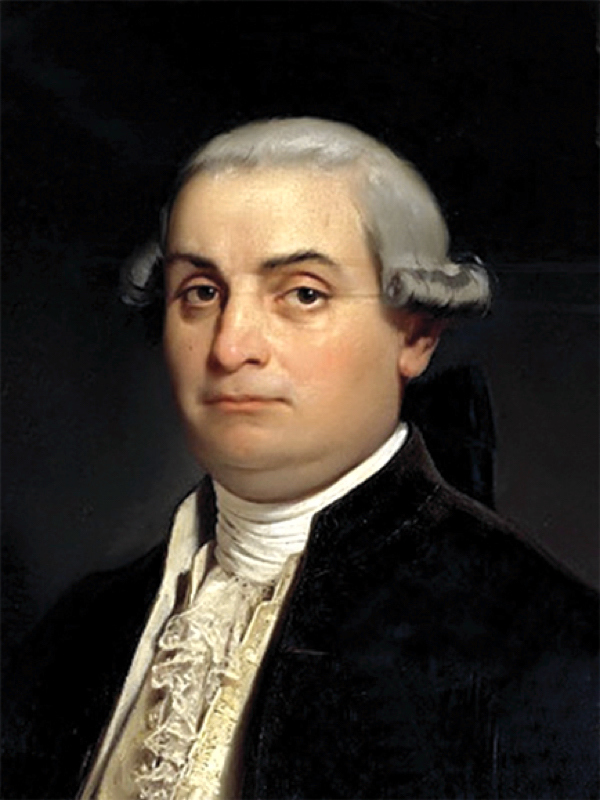
Beccaria’s work fundamentally changed the criminal justice systems in many countries for the better. As the first modern writer to have advocated for the abolition of capital punishment, he can be regarded as the founder of the anti-capital punishment movement that still exist in many countries today. Thanks to Beccaria, cruel and unusual punishments are no longer the norm in much of the world. As a result of his advocacy, a fathomless amount of human suffering and injustice has been avoided. For these reasons, Cesare Beccaria is our 38th Hero of Progress.

The recent killing of 49 innocent club goers in Orlando, Florida, has raised, once again, the issues of tolerance and violence in American society. Yet, even as we mourn the victims of hatred and violence, it is worthwhile to remind ourselves that, historically speaking, Americans live in very safe and tolerant times.
Let us start with public safety. As Harvard University psychologist Steven Pinker documented in his 2011 book The Better Angels of Our Nature, violence has been declining for centuries. In 1450, for example, Italian homicides averaged 73 per 100,000 people. England was relatively safe, with just over 13 homicides per 100,000 people.
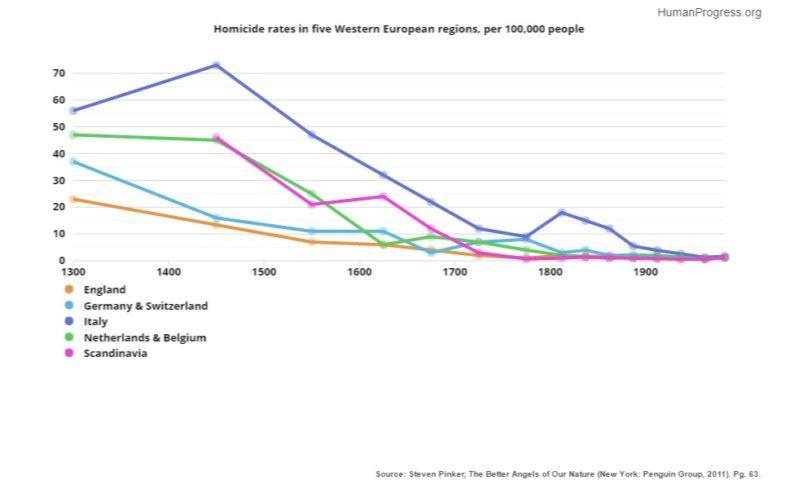
In 2011, in contrast, homicides in Great Britain and the United States averaged 1 and 4 per 100,000 people respectively. While America’s overall homicide rate remains higher than that in Great Britain, there is enormous regional divergence. In 2015, for example, the homicide rate in New England’s Massachusetts was 1.61 per 100,000, but it was 11.67 in the Deep South’s Louisiana.
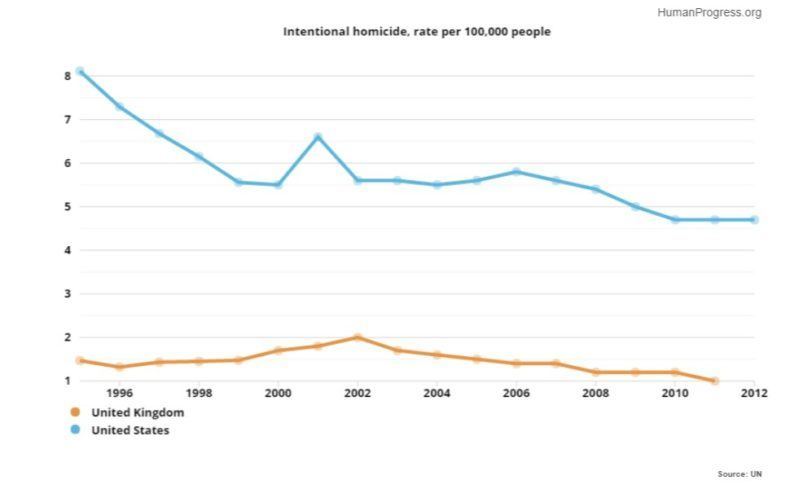
Overall, the homicide trend in America has been positive – mass shootings notwithstanding. Between June 18, 2015, when a suspected white supremacist killed 9 people in a historically black church in Charleston, South Carolina, and June 12, 2016, when a suspected Islamic extremist killed 49 people in a gay club in Orlando, Florida, 89 Americans died in mass shootings in the United States.
The population of the United States is approaching 324 million, which made the likelihood of dying in a mass shooting over the last 12 months 1 in 3.6 million. According to the National Weather Service, a U.S. government agency, the likelihood of being struck by lightning in 2014 was 1 in 1.2 million, by comparison. Such statistics are of no comfort to those who died and to their families, but they do put the evolution of violence in America in proper context.
Similarly encouraging patterns can be observed in American attitudes toward minorities, including blacks and gays. For example, even after the Civil War ended the institution of slavery, the lynching of black Americans continued in the Jim Crow south. Lynching plummeted rapidly over the following decades and disappeared completely mid-way through the 20th century.

In 1942, 68 percent of white Americans thought that blacks and whites should go to separate schools. By 1995, only 4 percent of American whites thought that. In 1958, 45 percent of white Americans said that they would “maybe” or “definitely” move if a black family moved in next door. That number fell to just 2 percent in 1997. So rare were segregationist attitudes by the mid-1990s that the federal government discontinued collection of such statistics.
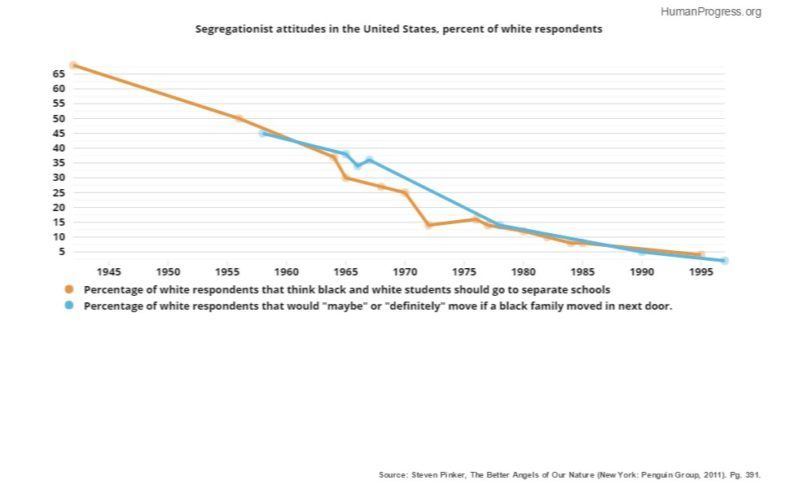
A higher level of segregationist attitudes in the United States was noted by the 2014 World Values Survey. The survey found that 6 percent of Americans were opposed to racially different neighbors. This number, however, includes not only whites opposed to black neighbors, but also blacks opposed to white neighbors, etc.
Overall, the survey ranked the United States 47th out of 60 countries surveyed. As such, the United States ranked better than the Netherlands, Germany, Estonia, Hong Kong, Taiwan, Japan, South Korea, Mexico, Ecuador and Peru.

On the opposite side of the spectrum was Azerbaijan, where 58 percent of the population was against racially different neighbors. Azerbaijan was followed by Libya with 55 percent, the Palestinian Authority with 44 percent, India with 41 percent, and Thailand with 40 percent.
When it comes to homosexuality, trends are similarly encouraging. If anything, toleration toward gays and lesbians has been increasing at a dramatic pace. In 1977, only 13 percent of Americans believed that homosexuality was innate. By 2015, 51 percent Americans recognized the importance of genetics in determining a person’s sexual orientation.
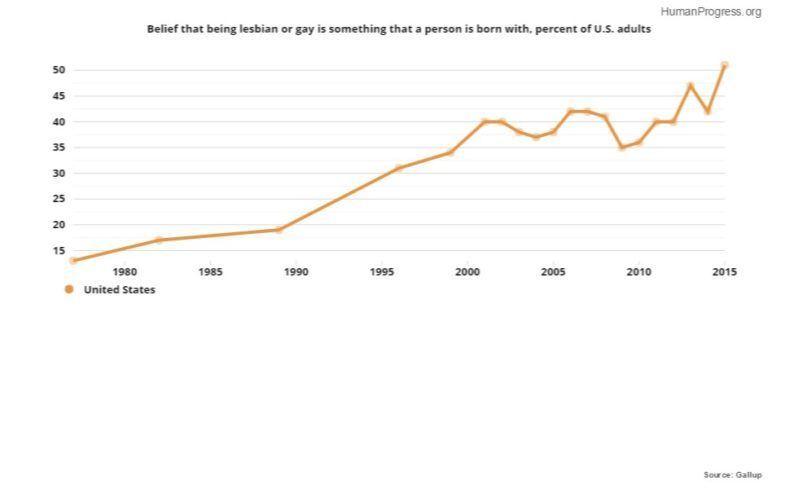
As late as 2002, only 38 percent of Americans believed that gay and lesbian relationships were morally acceptable. A mere 13 years later, 63 percent of Americans felt that way. Consider also that in 1996, only 27 percent of Americans supported gay marriage. By 2015, that number more than doubled with 60 percent of Americans supporting gay marriage.
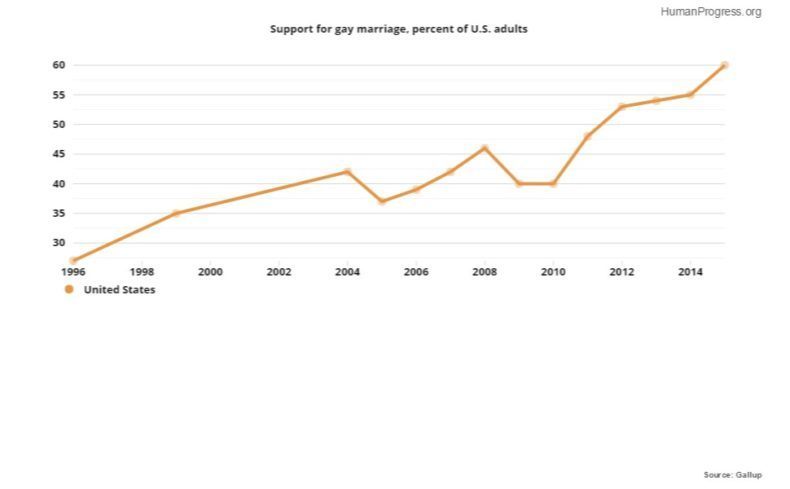
Over the last year, we have heard much about the intrinsic racism and homophobia in American society. I disagree. By historical and by global standards, America is a remarkably tolerant and safe place, a few deranged or evil individuals, such as the shooters in Charleston and Orlando, notwithstanding.
Moving forward, it is important to recognize a few immutable realities. First, complete physical safety and emotional serenity are impossible in a free society. Second, deranged or evil individuals, who are determined to kill innocent people, cannot be stopped by new laws and regulations or by the evolution of social and cultural norms. Third, law enforcement, no matter how quick and brave, cannot prevent some, perhaps most, casualties. In extremis, all citizens must look to their own devices to protect themselves and their loved ones from the predation of those whom law and social norms have not or could not stop.
This article was first published in CapX.
